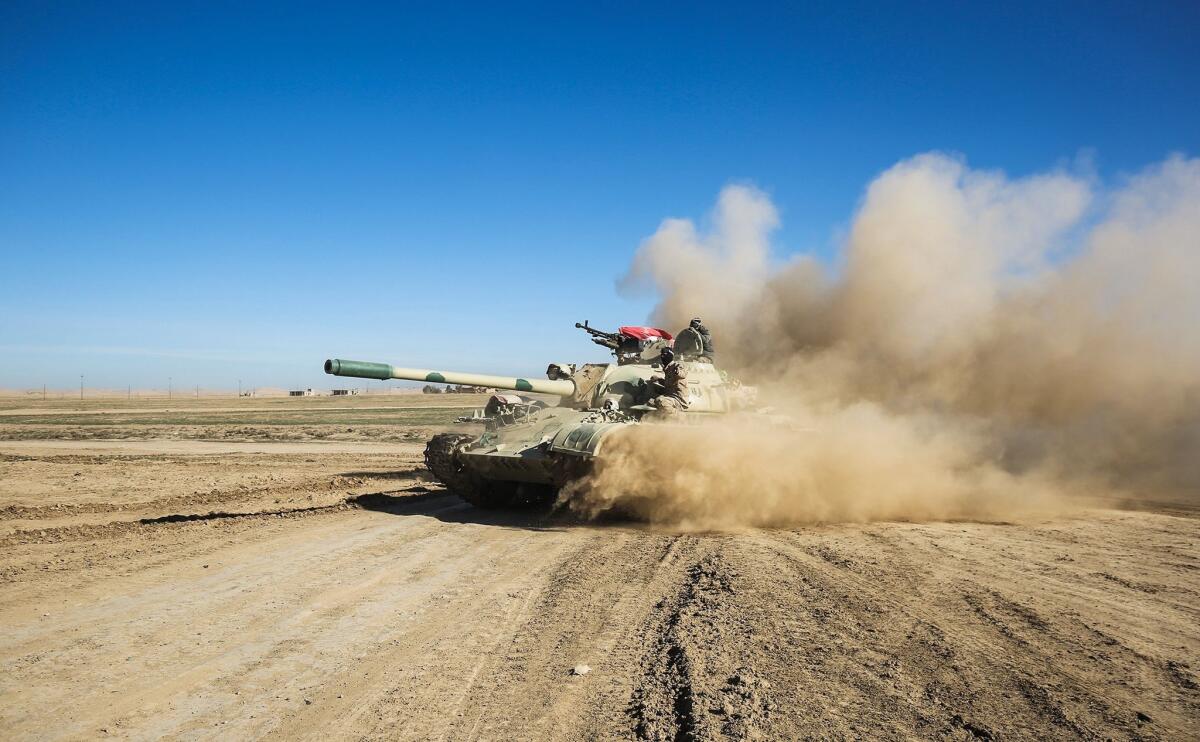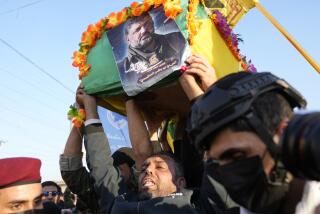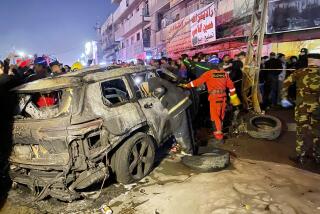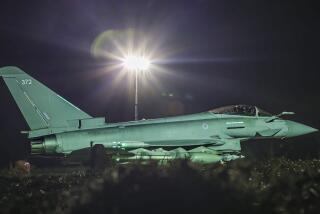Offensive to rout Islamic State out of western Mosul is underway, as U.S. steps up airstrikes

Iraqi forces early Sunday began a large-scale offensive to seize the western side of Mosul, Islamic State’s de facto capital in Iraq.
It was the long-expected second phase of the campaign to retake the remainder of the crucial city, Iraq’s second-largest, launched 26 days after the government declared that it had “liberated” the eastern part of the city.
Iraqi Prime Minister Haider Abadi announced the offensive early Sunday on state television.
“We announce the start of a new phase in the operation, we are coming to Nineveh to liberate the western side of Mosul,” he said. “Our forces are beginning the liberation of the citizens from the terror of [Islamic State].”
Throughout the night, a steady barrage targeted Islamic State positions just north of the village of Areyj, about seven miles outside of Mosul.
As the sun rose, the crash of ordnance crescendoed into a sustained volley. It was soon joined by the rumble of dozens of armored vehicles from the Iraqi federal police and Emergency Response Division, mustering near the village of Lazaaqah.
Sunday’s advance aimed to bring Iraqi forces to the town of Albu Seyf, just beyond Mosul’s southern edge.
Once there, Iraqi officials expect fierce resistance from the jihadists. The terrain is in Islamic State’s favor; Mosul’s western districts, poorer than those in the east, have narrower streets. It means the troops will have to clear buildings without the benefit of the tanks and Humvees they had used in eastern Mosul.
But on Sunday, troops appeared eager to begin.
“We will be victorious, God willing,” said one soldier riding on top of an armored vehicle as he mugged for a cameraman. Beside him, his colleague ululated.
“We’re all doing this in the service of Iraq. We want to protect our people,” said police officer Zaid Tareq, a 24-year-old Baghdad native.
An Isuzu pickup truck, with two large speakers blasting patriotic songs from its flatbed, added to the cacophony.
Interspersed among the columns were U.S. special forces, their M-RAP armored vehicles sporting stickers such as “It’s a free country. Live like it. Let’s ride!” Another had “Liberty Promise” scrawled in pink crayon on its bumper.
But the carnival-like atmosphere quickly dissipated when troops reached the hills beyond Lazaaqah. Bullets whistled past the soldiers’ heads.
Islamic State snipers hiding in the nondescript buildings of a village named Kafour had stopped the column’s advance.
“I want those houses destroyed,” shouted one commander into a walkie-talkie. “Go forward and take that position out.”
Moments later, a rocket launched from a Humvee slammed into a building on the village’s edge. On the adjacent mountain, a missile arced toward another set of structures.
Throughout the assault, helicopters streaked above, firing heavy machine guns and rockets ahead of the advancing columns.
American support for the operation has included daily airstrikes, intelligence, training and special operations forces advisors.
Despite the sight of U.S. special forces near the front lines, Defense Secretary James N. Mattis said Sunday during a visit to Arab allies in Abu Dhabi that there has been no change to rules of engagement regarding U.S. forces’ role in the Mosul operation since President Trump took office.
He plans to present the White House with a more aggressive plan to combat Islamic State by month’s end, but acknowledged that U.S. airstrikes pounded Islamic State targets in western Mosul from the air in the days ahead of the Iraqi assault, hitting militant command and control facilities.
The multinational coalition led by the U.S. has conducted more than 10,000 airstrikes against Islamic State targets in Iraq, the Pentagon said, while more than 70,000 Iraqi forces have been trained and equipped.
“The isolation phase has been going on for some time now,” Mattis said. “The attack into the city is something I don’t want to get into details about because I owe confidentiality to the troops who are actually making the attack.”
U.S. pilots say the airspace above western Mosul is thick with aircraft. At any given time, up to 50 warplanes are flying in an increasingly compressed area.
Many of the aircraft are drones scouring for targets. The overhead imagery and intelligence that’s captured is relayed to air commanders who cue coalition fighter jets to strike, helping the advance of Iraqi forces on the ground.
“We’re focused on intelligence collection to to make sure the Iraqis are successful in this mission,” said Air Force Brig. Gen. Chuck Corcoran, an air commander at an undisclosed base in the region..
Air Force Lt. Col. August “Pfoto” Pluger, an F-22 pilot and squadron commander, said American pilots have been busy operating over a compact area where dozens of strike aircraft circle high above western Mosul, which is more densely populated than eastern neighborhoods.
“Eastern Mosul was a little more open,” he said. “You could look out and identify things like Mosul University. In the west, it’s a high-density environment. People live in apartment buildings and areas that are in much closer quarters.”
Pilots have to remain mindful of the risk of hitting civilians, which has grown in western Mosul as the militants mix among communities and take up fighting positions inside mosques, schools and hospitals.
The U.S.-led coalition said Saturday that warplanes destroyed a building in a sprawling medical complex that was suspected to be repurposed as a Islamic State command hub. The Sunni Muslim extremist group later disputed the claim, saying the coalition airstrike killed 18 civilians, including women and children, and wounded 47 others.
U.S. air commanders insist that any building hit with an airstrike is watched for days to diminish the chance civilians are killed.
Iraqi commanders say it is too early to know the condition of civilians inside western Mosul, as the worst of the fighting is about to get underway.
The United Nations warned Saturday that the estimated 750,000 to 800,000 people in that part of the city are at “extreme” risk due to dwindling food and fuel supplies, as well as acute shortages of drinking water and electricity.
“People in the eastern part of the city had been terrorized before the offensive, yes, but they were not in the same dramatically dire circumstances that we believe those in the west to be,” Lise Grande, the U.N.’s humanitarian coordinator for Iraq, said in a phone interview Saturday.
But reaching the main part of the city could take time.
By mid-morning, the troops were still three miles away from Albu Seyf.
“May God bless you, oh sons of the Emergency Response Division,” blared a voice coming in over the radio.
To the side, Brig. Gen. Abbass Jboori, the division’s chief of staff, surveyed the field before conferring with an American special forces operator on where to place defensive positions.
“The terrain here is open and the enemy’s morale is shaken,” he said.
Asked what he expected in the way of resistance once troops advanced beyond Albu Seyf, he smiled.
“Mosul? Let’s go and see. “
Bulos reported from Qunaiterah, and Hennigan reported from Abu Dhabi
Bulos is a special correspondent.
ALSO
In Arab world, fresh doubts about the chances for a Palestinian state
In the half of Mosul freed from Islamic State, life returns to not-quite normal
Pakistan launches military crackdown as death toll in shrine bombing rises to 88
UPDATES:
11:20 a.m.: This article was updated with comments from a U.S. squadron commander.
7:10 a.m.: This article was updated with comments from Defense Secretary James N. Mattis, along with other U.S. military sources.
1:10 a.m.: This article was updated with additional details on the operation.
Feb. 19, 12:05 a.m.: This article was updated with a statement from the U.S.-led coalition in Iraq and additional background on U.S. operations.
This article was originally published on Feb. 18 at 10:30 p.m.
More to Read
Start your day right
Sign up for Essential California for news, features and recommendations from the L.A. Times and beyond in your inbox six days a week.
You may occasionally receive promotional content from the Los Angeles Times.







